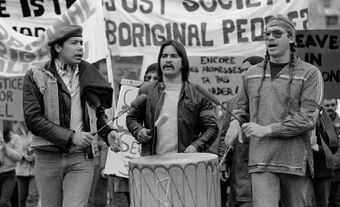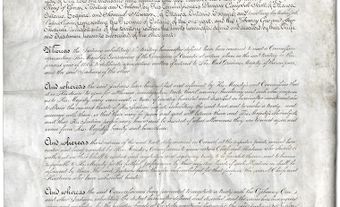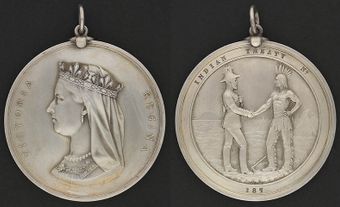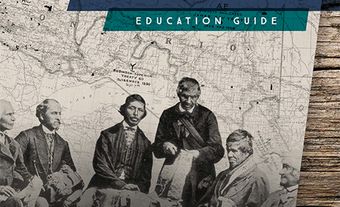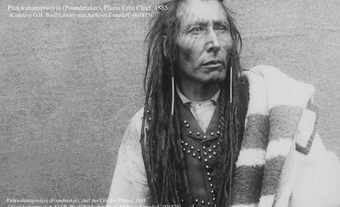The Numbered Treaties are a series of 11 treaties. A treaty is an agreement between two or more nations. The Numbered Treaties were signed by the Canadian government and Indigenous people. All 11 treaties were signed between 1871 and 1921. The Numbered Treaties cover parts of British Columbia, Alberta, Saskatchewan, Manitoba, Ontario. They also cover portions of Yukon and the Northwest Territories.
The treaties provided the Canadian government with land. The government wanted land for industrial development and white settlement. In exchange, the government promised Indigenous people special rights and benefits. These treaty terms are controversial and contested. The Numbered Treaties have ongoing legal, social, and economic impacts on Indigenous communities. (See also Treaties with Indigenous Peoples in Canada.)
(This is a plain-language summary of the Numbered Treaties. If you are interested in reading about this topic in more depth, please see our full-length entry, Numbered Treaties.)

List of Numbered Treaties
The following chart lists the Numbered Treaties and the years they were signed. Click on Treaties 1–11 to read more about these specific agreements.
|
Treaty Number |
Date of Treaty |
|
1871 |
|
|
1871 |
|
|
1873 |
|
|
1874 |
|
|
1875 |
|
|
1876 |
|
|
1877 |
|
|
1899 |
|
|
1905 |
|
|
1906 |
|
|
1921 |
Historical Context
After Confederation, the Canadian government wanted to expand westward. It wanted the lands of the Hudson Bay Company (HBC). This included Rupert’s Land and the North-Western Territory. These lands were sources of valuable natural resources and vast space. They could be used for European immigration. They could also be used for industrial and commercial developments. Many Canadian politicians feared the USA would take these lands if Canada did not. (See also Manifest Destiny.) In 1870, the Canadian government obtained Rupert’s Land and the North-Western Territory.
There was an agreement with the HBC for the transfer of these lands. In it, Canada agreed to address all Indigenous claims to those lands. The government planned to negotiate treaties with Indigenous people for the land. The government used the 1850 Robinson Treaties as a model for the new treaties. The 11 Numbered Treaties were signed between 1871 and 1921. These treaties gave the government control of the land. In exchange, Indigenous people were promised goods, reserve lands, annual payments and hunting and fishing rights. (See also Indigenous Territory.)
Why Did Canada Sign the Treaties?
The Canadian government signed the treaties to gain access to Indigenous lands. Each of the treaties had different benefits for the Canadian government.
Treaties 1 to 7 secured Canada’s claim to lands north of the US-Canada border. They enabled the construction of the Canadian Pacific Railway. They also opened the lands of the North-West Territories to agricultural settlement.
Treaties 8 to 11 made it easier for the government to access natural resources in northern Canada. The treaties opened the West for settlement. They also secured a connection between British Columbia and central Canada.
The Numbered Treaties were used to assimilate Indigenous peoples into Canadian society. The government wanted Indigenous peoples to adopt the values and behaviors of white settlers. For example, the treaties encouraged the farming techniques and settlement patterns of Europeans. Indian agents made sure government policies on reserves were followed. Indian agents were representatives of the Canadian government on reserves from the 1830s to the 1960s. Other policies of assimilation included the Indian Act and pass system.
Why Did Indigenous Peoples Sign the Treaties?
Many different Indigenous nations signed the Numbered Treaties. Each Indigenous nation had their own reason for signing the treaties. On the plains, many Indigenous people were suffering from the destruction of traditional economies. The bison was overhunted by settlers and went extinct. The bison had provided Indigenous people with food and materials for clothes, tools and other goods. Some Indigenous leaders signed the treaties to prevent more hunger and starvation. From some Indigenous perspectives, the treaties were a way to make a bad situation better.
Not all Indigenous leaders were happy with the treaty terms. For example, Plains Cree chief Mistahimaskwa (Big Bear) refused to sign Treaty 6 in 1876. He feared that his people would lose their freedom. Many Indigenous peoples felt that their concerns would not be taken seriously by the Canadian government. They feared they stood to lose more than gain. Some leaders signed the treaties because they saw no other option.
Different Interpretations
There are different interpretations of the treaties. These differences have led to disputes between the Canadian government and Indigenous people.
Some have argued that Indigenous leaders did not understand they were surrendering their lands. The concept of owning land is different in European and Indigenous worldviews. Indigenous people may have interpreted the treaties as ways to share the land, not own it. Errors in translation may have also caused misunderstandings.
Some Indigenous argue that the government failed to deliver on verbal commitments. These are promises that weren’t necessarily written down. They are known as “outside promises.”
Impacts and Significance

The Numbered Treaties have had long-lasting legal, social, and economic impacts on Indigenous people. The creation of reserves and other policies of assimilation have affected Indigenous ways of life. Ongoing disputes about the treaty terms have led to modern land claims.
Despite flaws in the treaty-making process, the Numbered Treaties are important. They have helped to guide the relationship between the Canadian government and Indigenous people. They provide a context of mutual responsibilities and rights. As modern land claims are resolved, the government and Indigenous leaders work together towards improving the lives of Indigenous people.

 Share on Facebook
Share on Facebook Share on X
Share on X Share by Email
Share by Email Share on Google Classroom
Share on Google Classroom
